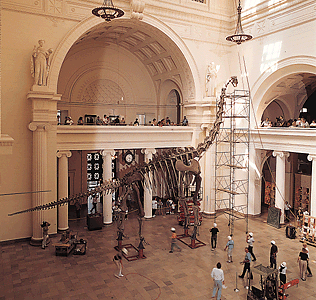April 5-11, 2012, Current Events Lesson Plan
Current Event:
Scientists recently announced the discovery of fossils of a large feathered dinosaur in China. The dinosaur is far larger than other feathered dinosaurs scientists have discovered in recent years. Paleontologists at the Chinese Academy of Sciences in Beijing, the capital, have named the new species Yutyrannus huali–”beautiful feathered tyrant”–because it is similar in size and shape to Tyrannosaurus rex.

A museum display of a dinosaur skeleton, such as this Brachiosaurus, a sauropod, consists of fossilized bones mounted on a framework. Missing bones may be replaced with artificial pieces. Finding all of the bones of a large dinosaur is very rare. (John Weinstein © The Field Museum, Chicago Neg#GN86807.10)
Objective:
Scientists were surprised to discover a large feathered dinosaur. The Behind the Headlines news story and related World Book articles helps students understand why this was such a groundbreaking find.
Words To Know:
- Beijing
- China
- Cretaceous Period
- dinosaur
- fossils
- Liaoning Province
- paleontologist
- sauropod
- Tyrannosaurus rex
Discussion Topics:
1. The dinosaurs were hunting a sauropod when all were killed and preserved as fossils. Ask your students how dinosaurs such as Yutyrannus huali and Tyrannosaurus rex differed from sauropods.
2. Scientists are confident that Yutyrannus huali could not fly. Ask your students why they think it may have had feathers. (In addition to providing insulation, feathers could have also been used for courtship displays.)
3. The fossils were discovered in a small quarry in Liaoning Province in northeastern China. Ask your students to use World Book’s Explore the World feature to locate China. Liaoning Province is northeast of Beijing.
4. Use World Book’s Timelines feature to create a timeline of periods in which dinosaurs lived. (Dinosaurs first appeared in the Triassic Period, which began about 251 million years ago, and flourished in the Jurassic and Cretaceous periods before becoming extinct about 65 million years ago.) Ask them to use World Book to find when their favorite dinosaurs lived and include them in the timeline in the order of their appearance.


